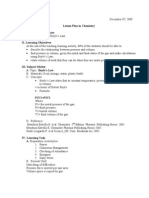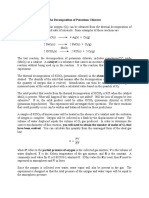Homework 4
Homework 4
Uploaded by
lux0008Copyright:
Available Formats
Homework 4
Homework 4
Uploaded by
lux0008Copyright
Available Formats
Share this document
Did you find this document useful?
Is this content inappropriate?
Copyright:
Available Formats
Homework 4
Homework 4
Uploaded by
lux0008Copyright:
Available Formats
CHEM 131
F. Paesani Homework No. 4 on Chapter 4 Due in class Friday, February 3 Winter 2012
Note: As I mentioned in the previous assignments, the true and false" Levine problems are very instructive. While the solution manual has the quick answers, I urge you strongly to think hard about all of these because they really test your conceptual understanding. Make sure you understand why you are answering T or F. To be considered properly answered (e.g., for grading purposes on homework or exams), you must provide some (short) reasoning for your answer. Another note: When problems deal with gases and you are not told otherwise, you can assume that the gases are ideal. If some data are not reported in the text, that implies that they can be found in the tables on the back of the book or can easily found in internet. 1. Levine 4.1 2. Levine 4.19 3. Levine 4.22 4. Levine 4.23 5. Levine 4.27 6. A sample of ideal gas that initially occupies 15.0 L at 250 K and 1.00 atm is compressed isothermally. To what volume must the gas be compressed to reduce its entropy by 5.0 J K-1? 7. Calculate G of 25 g of ethanol (mass density 0.789 g cm-3) when the pressure is increased isothermally from 1 atm to 3000 atm. 8. Calculate the change in the entropy of the system and also the change in the entropy of the surroundings, and the resulting total change in entropy, when a sample of nitrogen gas of mass 14 g at 298 K and 1.00 bar doubles its volume in (a) an isothermal reversible expansion, (b) an isothermal irreversible expansion against Pext = 0, and (c) an adiabatic reversible expansion. 9. Calculate (a) the maximum non-expansion work, and (b) the maximum work that can be obtained from the freezing of supercooled water at -5 oC and 1.0 atm. The densities of water and ice are 0.999 g cm-3 and 0.917 g cm-3, respectively, at -5 oC.
10. Remember the following problem in Homework No. 2: Consider a perfect gas contained in a cylinder and separated by a frictionless adiabatic piston into two sections, A and B; section B is in contact with a water bath that maintains it at constant temperature. Initially TA = TB = 300 K, VA = VB = 2.00 L, and nA = nB = 3.00 mol. Heat is supplied to Section A and the piston moves to the right reversibly until the final volume of Section B is 1.00 L. There you calculated a bunch of quantities all related to the First Law. Now I want you to do additional calculations for the same situation, now associated with the Second Law. Calculate (a) SA and SB, (b) AB, (c) GB, (d) S of the total system and its surroundings. Note that AA and GA cannot be determined from the information given and your current arsenal of tools. Assume CV;m = 20 J K-1 mol-1.
You might also like
- Science 4thQ Module 1Document3 pagesScience 4thQ Module 1Charlie DaduyoNo ratings yet
- (Elliott Lira) Introductory Chemical Engineering Thermodynamics PDFDocument940 pages(Elliott Lira) Introductory Chemical Engineering Thermodynamics PDFDavid Ainet0% (1)
- Exam 3 SolutionsDocument9 pagesExam 3 SolutionsYoli ArriagaNo ratings yet
- General Chemistry 1 Week 5 6Document10 pagesGeneral Chemistry 1 Week 5 6Emmanuel ValenzuelaNo ratings yet
- Gen Chem Module 2 AnswerDocument15 pagesGen Chem Module 2 AnswerArgie BanayosNo ratings yet
- Clicker-Questions-Chapter 8-April-28thDocument5 pagesClicker-Questions-Chapter 8-April-28thteenwolf4006No ratings yet
- Boyle's Law22 Lesson PlanDocument3 pagesBoyle's Law22 Lesson PlanMontesa Allana Ea82% (17)
- Final Lesson Plan For Science 10Document4 pagesFinal Lesson Plan For Science 10Ryan Lloyd Labartine100% (1)
- Chem Mid Exam Code 4Document6 pagesChem Mid Exam Code 4lenlucy13frNo ratings yet
- Practice Exam III Chap5-6Document4 pagesPractice Exam III Chap5-6Jovenil BacatanNo ratings yet
- Ideal Gas LawDocument15 pagesIdeal Gas LawajclfortesNo ratings yet
- Homework 2Document2 pagesHomework 2lux0008No ratings yet
- Entry-2102-Boyles Law WorksheetDocument4 pagesEntry-2102-Boyles Law WorksheetRizky HermawanNo ratings yet
- States of MatterDocument32 pagesStates of MatterTaerg SemajNo ratings yet
- Boyle's LawDocument7 pagesBoyle's LawCindy AndersonNo ratings yet
- PC1431 MasteringPhysics Assignment 7Document16 pagesPC1431 MasteringPhysics Assignment 7stpmoment0% (4)
- S2Document5 pagesS2NorphinNo ratings yet
- (Chem 16) Long Exam 3 Reviewer DDocument4 pages(Chem 16) Long Exam 3 Reviewer DRoland FrancoNo ratings yet
- KMT ws2Document10 pagesKMT ws2Troy MateoNo ratings yet
- HW4Document2 pagesHW4AsalinaNo ratings yet
- Test Ch.10: Multiple ChoiceDocument6 pagesTest Ch.10: Multiple ChoiceMj LeeNo ratings yet
- Final Examination Chemistry Class XI 2022Document4 pagesFinal Examination Chemistry Class XI 2022XYZNo ratings yet
- Gas LawsDocument27 pagesGas LawsGenesis Ng0% (3)
- Joseph Louis Gay-Lussac Absolute TemperatureDocument4 pagesJoseph Louis Gay-Lussac Absolute TemperatureMira VeranoNo ratings yet
- Question 1: Answer The Following QuestionsDocument4 pagesQuestion 1: Answer The Following Questionsntzrbpcx4nNo ratings yet
- 13 Partial Pressures of GasesDocument6 pages13 Partial Pressures of GasesTanisha Marie100% (1)
- Science Grade 10: Quarter 4 - Behavior of GasesDocument15 pagesScience Grade 10: Quarter 4 - Behavior of GasesalindongaprilmaeNo ratings yet
- Science IiiiiiiiiiiDocument26 pagesScience IiiiiiiiiiiSean CezarNo ratings yet
- Q4 Science10 Week1 LAS2Document1 pageQ4 Science10 Week1 LAS2AvaricioElPecadoNo ratings yet
- Science Grade 10 Quarter 4Document60 pagesScience Grade 10 Quarter 4Christian Jay JotojotNo ratings yet
- Example Exercise 11.1: Gas Pressure ConversionDocument14 pagesExample Exercise 11.1: Gas Pressure ConversionJose FNo ratings yet
- Decomposição Do Clorato de PotássioDocument5 pagesDecomposição Do Clorato de PotássioVitorArrudaNo ratings yet
- Summative Test 1 Behavior of GasesDocument2 pagesSummative Test 1 Behavior of GasesPangangan NHS100% (9)
- Ideal Gas Law ProblemsDocument4 pagesIdeal Gas Law Problemsapi-258903855No ratings yet
- PV NRT CalculationsDocument9 pagesPV NRT CalculationsmusaveerNo ratings yet
- Science 10 Q4 LAS Week 1.2Document4 pagesScience 10 Q4 LAS Week 1.2Eainne David DocogNo ratings yet
- Q4 Behavior of GasesDocument31 pagesQ4 Behavior of Gasesfsean2008No ratings yet
- Experiment No. 2 Molar Mass of A Volatile LiquidDocument5 pagesExperiment No. 2 Molar Mass of A Volatile LiquidJericho MaganaNo ratings yet
- Heat of Combustion of Candle WaxDocument14 pagesHeat of Combustion of Candle Waxmarzinus0% (1)
- Quiz GaseswarmupDocument2 pagesQuiz Gaseswarmupapi-345951170No ratings yet
- Learners' Activity Sheet (LAS)Document5 pagesLearners' Activity Sheet (LAS)MARIA THEA CALAGUASNo ratings yet
- Chem Ia FinalDocument13 pagesChem Ia FinalAngelina TomacNo ratings yet
- The Kinetic Molecular Theory: General Chemistry 1 Reviewer: 2nd QuarterDocument15 pagesThe Kinetic Molecular Theory: General Chemistry 1 Reviewer: 2nd QuarterJerome jeromeNo ratings yet
- Gas Law NotesDocument6 pagesGas Law NotesLloydDagsilNo ratings yet
- 2 Eso 1 Evaluación FyqDocument5 pages2 Eso 1 Evaluación Fyqserual.sergioNo ratings yet
- Contest 10Document3 pagesContest 10bakosua141No ratings yet
- PhyChem Lab Problem Set No 1Document9 pagesPhyChem Lab Problem Set No 1Mark Ryan TripoleNo ratings yet
- Physics 2 PTDocument12 pagesPhysics 2 PTKatrina NuegaNo ratings yet
- Sebonga 08 ELMS Homework 1 Problem Solving ARGDocument3 pagesSebonga 08 ELMS Homework 1 Problem Solving ARGNoel SebongaNo ratings yet
- Chemistry Ii Unit 1 Paper 1Document6 pagesChemistry Ii Unit 1 Paper 1maxime namaNo ratings yet
- ARCO SAT Subject Chemistry Practice TestDocument25 pagesARCO SAT Subject Chemistry Practice TesthamdardiNo ratings yet
- Physical Chemistry First Thermodynamics Review ProblemsDocument2 pagesPhysical Chemistry First Thermodynamics Review Problemsquangthach89No ratings yet
- Chemistry 1: Quarter 4: Module 4Document3 pagesChemistry 1: Quarter 4: Module 4Rain AlmsNo ratings yet
- LAS No.3 and OUTPUT 1 QUARTER 4 Science Class Teacher Bhel Austria ClassDocument2 pagesLAS No.3 and OUTPUT 1 QUARTER 4 Science Class Teacher Bhel Austria Class9nc7zs7j8vNo ratings yet
- A Detailed Lesson Plan in Grade IX ScienceDocument4 pagesA Detailed Lesson Plan in Grade IX ScienceAdrian Tastar100% (1)
- Summative Assessment Gas LawsDocument2 pagesSummative Assessment Gas LawsMarian Anion-GauranoNo ratings yet
- 4thqrtly Sience10 2017 18Document11 pages4thqrtly Sience10 2017 18gerald100% (1)
- Temperature and Pressure Practice ProblemsDocument4 pagesTemperature and Pressure Practice ProblemsDominic LibradillaNo ratings yet
- Practice Makes Perfect in Chemistry: The Physical Behavior of MatterFrom EverandPractice Makes Perfect in Chemistry: The Physical Behavior of MatterRating: 5 out of 5 stars5/5 (1)
- Practice Makes Perfect in Chemistry: The Physical Behavior of Matter with AnswersFrom EverandPractice Makes Perfect in Chemistry: The Physical Behavior of Matter with AnswersNo ratings yet
- PH ControlDocument10 pagesPH Controllux0008No ratings yet
- Photocatalytic Degradation of Azo Dyes by Supported Tio + Uv in Aqueous SolutionDocument7 pagesPhotocatalytic Degradation of Azo Dyes by Supported Tio + Uv in Aqueous Solutionlux0008No ratings yet
- PH SystemsDocument12 pagesPH Systemslux0008No ratings yet
- Team 4 Final PresentationDocument25 pagesTeam 4 Final Presentationlux0008No ratings yet
- Team 3Document21 pagesTeam 3lux0008No ratings yet
- Spintronics NanomagnetismDocument15 pagesSpintronics Nanomagnetismlux0008No ratings yet
- Lecture Nano 13Document33 pagesLecture Nano 13lux0008No ratings yet
- Nano Materials For Potential Cardiovascular and Other Biomedical ApplicationsDocument54 pagesNano Materials For Potential Cardiovascular and Other Biomedical Applicationslux0008No ratings yet
- The Many Forms of Carbon: - BondsDocument19 pagesThe Many Forms of Carbon: - Bondslux0008No ratings yet
- Simplex MethodDocument54 pagesSimplex MethodForbes Eagara100% (4)
- Session 2Document4 pagesSession 2vijayakumar100% (1)
- ch17-SLIDE - (2) Data Communications and Networking by Behrouz A.ForouzanDocument50 pagesch17-SLIDE - (2) Data Communications and Networking by Behrouz A.ForouzanXP2009No ratings yet
- MSDS DowDocument10 pagesMSDS DowAnonymous cePb20No ratings yet
- 2016 Bushmaster CatalogDocument70 pages2016 Bushmaster CatalogMario Lopez100% (1)
- Prolog FundamentalsDocument116 pagesProlog Fundamentalsparmararun21No ratings yet
- Author Insights Steve FlindersDocument4 pagesAuthor Insights Steve FlindersEmily JamesNo ratings yet
- Dry-Barrel Fire Hydrant FIG.F0733-250Document2 pagesDry-Barrel Fire Hydrant FIG.F0733-250mohamed KotpNo ratings yet
- Kernel Density Estimation (KDE) in Excel TutorialDocument8 pagesKernel Density Estimation (KDE) in Excel TutorialNumXL ProNo ratings yet
- Dutch Companies in Malaysia June 2012Document24 pagesDutch Companies in Malaysia June 2012angalc557No ratings yet
- Cts 9009plusDocument6 pagesCts 9009plusNila AkterNo ratings yet
- Kemper EchoDocument56 pagesKemper EchoEileen McMahonNo ratings yet
- Aifv 1: Type Place of OriginDocument7 pagesAifv 1: Type Place of OriginpcojediNo ratings yet
- DHCP OptionsDocument4 pagesDHCP OptionsKule MemphisNo ratings yet
- Bapi Construction Railway Infrastructure Ltd.Document6 pagesBapi Construction Railway Infrastructure Ltd.saurabh kumarNo ratings yet
- Geothermoptimal: Advanced Conformance Control To Maximize Egs MW PotentialDocument1 pageGeothermoptimal: Advanced Conformance Control To Maximize Egs MW Potentialsouvikbiswas.educationalNo ratings yet
- Mixing Guide - How To Mix Music (Part 1)Document12 pagesMixing Guide - How To Mix Music (Part 1)SteveJonesNo ratings yet
- Optimize Oracle On LinuxDocument44 pagesOptimize Oracle On LinuxEmilio SosaNo ratings yet
- Woods Manual WCD2Pro WCD3Pro WCD4Pro 2019Document105 pagesWoods Manual WCD2Pro WCD3Pro WCD4Pro 2019Bogdan BrieNo ratings yet
- en v2.0 Analogue ComparatorDocument3 pagesen v2.0 Analogue ComparatorManuela Risquez LopezNo ratings yet
- 01 Smoke Extract Fans - j46Document96 pages01 Smoke Extract Fans - j46Mahin ShaNo ratings yet
- Advance Java PDFDocument125 pagesAdvance Java PDFAinesh GuptaNo ratings yet
- An Empirical Investigation of Consumer Memory, Attitude, and Perceptions Toward Pioneer and Follower Brands (Alpert Kamins)Document13 pagesAn Empirical Investigation of Consumer Memory, Attitude, and Perceptions Toward Pioneer and Follower Brands (Alpert Kamins)Rizka Sarastri SumardionoNo ratings yet
- 10kva Proposal Tubular 1Document1 page10kva Proposal Tubular 1ucheNo ratings yet
- What Is The Difference Between CSE and ICTDocument10 pagesWhat Is The Difference Between CSE and ICTmmahmoudNo ratings yet
- 10987C 01 PDFDocument33 pages10987C 01 PDFAyaminNo ratings yet
- Ac Total Interference StudyDocument199 pagesAc Total Interference StudyPremNo ratings yet
- AHRI Standard 440-2008 Performance Rating of Room Fan CoilsDocument10 pagesAHRI Standard 440-2008 Performance Rating of Room Fan CoilsGustiuc MihaiNo ratings yet
- 20 SQL Exercises For Practice: Table Structure and SchemaDocument12 pages20 SQL Exercises For Practice: Table Structure and SchemaChaitanya IT Returns100% (3)
- 0100CT1901 Sec-01 PDFDocument44 pages0100CT1901 Sec-01 PDFBobby FischerNo ratings yet


































































































